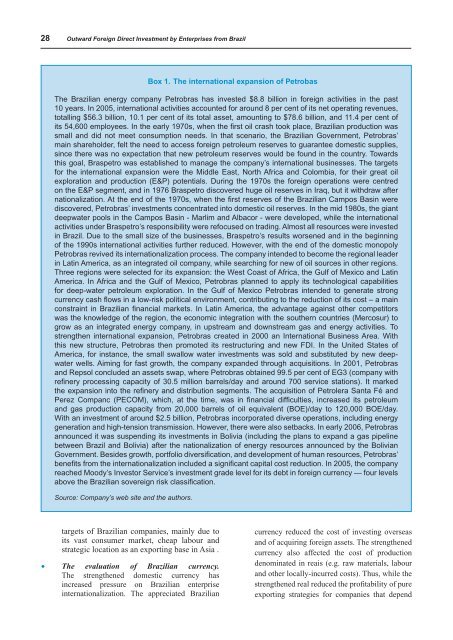Global Players from Emerging Markets: Strengthening ... - Unctad
Global Players from Emerging Markets: Strengthening ... - Unctad
Global Players from Emerging Markets: Strengthening ... - Unctad
You also want an ePaper? Increase the reach of your titles
YUMPU automatically turns print PDFs into web optimized ePapers that Google loves.
28 Outward Foreign Direct Investment by Enterprises <strong>from</strong> Brazil<br />
targets of Brazilian companies, mainly due to<br />
its vast consumer market, cheap labour and<br />
strategic location as an exporting base in Asia .<br />
• The evaluation of Brazilian currency.<br />
The strengthened domestic currency has<br />
increased pressure on Brazilian enterprise<br />
internationalization. The appreciated Brazilian<br />
Box 1. The international expansion of Petrobas<br />
The Brazilian energy company Petrobras has invested $8.8 billion in foreign activities in the past<br />
10 years. In 2005, international activities accounted for around 8 per cent of its net operating revenues,<br />
totalling $56.3 billion, 10.1 per cent of its total asset, amounting to $78.6 billion, and 11.4 per cent of<br />
its 54,600 employees. In the early 1970s, when the first oil crash took place, Brazilian production was<br />
small and did not meet consumption needs. In that scenario, the Brazilian Government, Petrobras’<br />
main shareholder, felt the need to access foreign petroleum reserves to guarantee domestic supplies,<br />
since there was no expectation that new petroleum reserves would be found in the country. Towards<br />
this goal, Braspetro was established to manage the company’s international businesses. The targets<br />
for the international expansion were the Middle East, North Africa and Colombia, for their great oil<br />
exploration and production (E&P) potentials. During the 1970s the foreign operations were centred<br />
on the E&P segment, and in 1976 Braspetro discovered huge oil reserves in Iraq, but it withdraw after<br />
nationalization. At the end of the 1970s, when the first reserves of the Brazilian Campos Basin were<br />
discovered, Petrobras’ investments concentrated into domestic oil reserves. In the mid 1980s, the giant<br />
deepwater pools in the Campos Basin - Marlim and Albacor - were developed, while the international<br />
activities under Braspetro’s responsibility were refocused on trading. Almost all resources were invested<br />
in Brazil. Due to the small size of the businesses, Braspetro’s results worsened and in the beginning<br />
of the 1990s international activities further reduced. However, with the end of the domestic monopoly<br />
Petrobras revived its internationalization process. The company intended to become the regional leader<br />
in Latin America, as an integrated oil company, while searching for new of oil sources in other regions.<br />
Three regions were selected for its expansion: the West Coast of Africa, the Gulf of Mexico and Latin<br />
America. In Africa and the Gulf of Mexico, Petrobras planned to apply its technological capabilities<br />
for deep-water petroleum exploration. In the Gulf of Mexico Petrobras intended to generate strong<br />
currency cash flows in a low-risk political environment, contributing to the reduction of its cost – a main<br />
constraint in Brazilian financial markets. In Latin America, the advantage against other competitors<br />
was the knowledge of the region, the economic integration with the southern countries (Mercosur) to<br />
grow as an integrated energy company, in upstream and downstream gas and energy activities. To<br />
strengthen international expansion, Petrobras created in 2000 an International Business Area. With<br />
this new structure, Petrobras then promoted its restructuring and new FDI. In the United States of<br />
America, for instance, the small swallow water investments was sold and substituted by new deepwater<br />
wells. Aiming for fast growth, the company expanded through acquisitions. In 2001, Petrobras<br />
and Repsol concluded an assets swap, where Petrobras obtained 99.5 per cent of EG3 (company with<br />
refinery processing capacity of 30.5 million barrels/day and around 700 service stations). It marked<br />
the expansion into the refinery and distribution segments. The acquisition of Petrolera Santa Fé and<br />
Perez Companc (PECOM), which, at the time, was in financial difficulties, increased its petroleum<br />
and gas production capacity <strong>from</strong> 20,000 barrels of oil equivalent (BOE)/day to 120,000 BOE/day.<br />
With an investment of around $2.5 billion, Petrobras incorporated diverse operations, including energy<br />
generation and high-tension transmission. However, there were also setbacks. In early 2006, Petrobras<br />
announced it was suspending its investments in Bolivia (including the plans to expand a gas pipeline<br />
between Brazil and Bolivia) after the nationalization of energy resources announced by the Bolivian<br />
Government. Besides growth, portfolio diversification, and development of human resources, Petrobras’<br />
benefits <strong>from</strong> the internationalization included a significant capital cost reduction. In 2005, the company<br />
reached Moody’s Investor Service’s investment grade level for its debt in foreign currency — four levels<br />
above the Brazilian sovereign risk classification.<br />
Source: Company’s web site and the authors.<br />
currency reduced the cost of investing overseas<br />
and of acquiring foreign assets. The strengthened<br />
currency also affected the cost of production<br />
denominated in reais (e.g. raw materials, labour<br />
and other locally-incurred costs). Thus, while the<br />
strengthened real reduced the profitability of pure<br />
exporting strategies for companies that depend

















